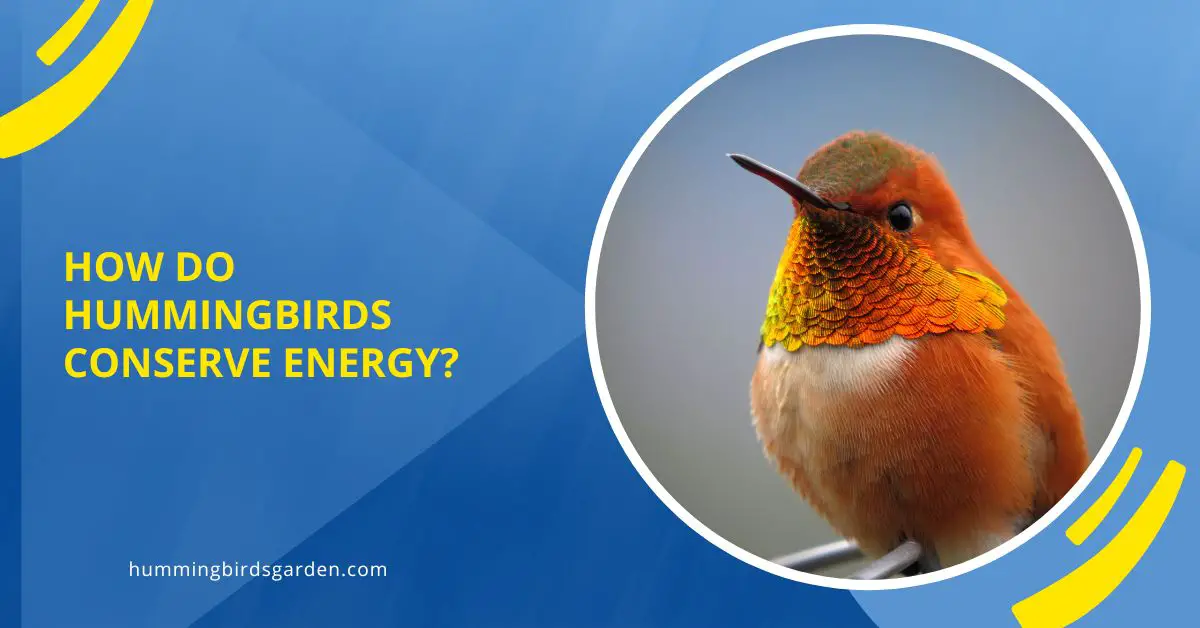Did you know that hummingbird can fly breathtakingly fast, reaching speeds up to 34 miles per hour? With this incredible ability also comes the challenge of conserving energy. In this article, we will discuss the various mechanisms employed by hummingbirds to conserve energy as they engage in their daily activities.
In addition, we will touch on the unique aspects of their anatomy and physiology, as well as their behavior, that contribute to energy conservation. By the end of the article, you will have a better understanding of the extraordinary characteristics that enable these small birds to thrive in their environment.
Most birds consume large amounts of energy to maintain their rapid metabolism and high body temperatures. Hummingbirds, with their fast-paced lifestyle, need effective energy conservation strategies to survive. Let’s delve into their fascinating world and explore how they accomplish this seemingly impossible feat.
Understanding the Hummingbird’s Metabolism
Basal Metabolic Rate and Torpor
One of the main ways hummingbirds conserve energy is by managing their basal metabolic rate (BMR). BMR is the amount of energy that an organism expends at rest in a thermoneutral environment. To accomplish this, hummingbirds enter a state called torpor.
Torpor is a short-term hibernation-like state where the bird’s BMR and body temperature are significantly reduced. By entering torpor, hummingbirds can save up to 60% of their energy at night when they are not actively feeding.

High-Efficiency Flight Muscles
Another factor contributing to hummingbirds’ energy conservation is their flight muscles’ efficiency. These muscles have a high oxidative capacity, meaning they are very effective at using oxygen to produce energy. This allows them to generate the power needed to support their rapid wingbeats while keeping energy consumption low.
Anatomy: Specialized Features for Energy Conservation
Efficient Respiratory System
Hummingbirds possess a highly efficient respiratory system, allowing for rapid gas exchange and oxygen delivery to their flight muscles. This rapid oxygen uptake and carbon dioxide clearance mean that they can maintain energy-intensive hovering flights without depleting their energy resources too quickly.
Energy-Storing Tendons
To further conserve energy, hummingbirds have elastic tendons in their wings that can store and release energy, functioning like a biological spring. This passive wing movement aids in their hovering ability, reducing the energetic cost of maintaining a stable position during flight.
Behavioral Adaptations for Energy Conservation
Strategic Feeding Patterns
Hummingbirds will consume small, frequent meals to keep their energy levels high. Additionally, they often choose to feed from energy-rich nectar sources or catch insects that provide a high-energy meal. This strategic feeding behavior ensures that they always have enough energy to sustain their flight and other daily activities.
Intermittent Glides in Flight
When traveling long distances, hummingbirds will alternate between powered flight and intermittent glides. Gliding allows the bird to cover a greater distance with less energy expended, ultimately conserving energy during travel.
Perching vs. Hovering
While hummingbirds are renowned for their hovering ability, they will often choose to perch while feeding if possible. Perching on a branch or feeder takes the strain off their flight muscles, reducing the energy needed to consume their meal.
Choosing the Right Habitat and Migratory Patterns
Hummingbirds will select habitats with abundant floral resources to minimize energy expended in search of food. Furthermore, they can demonstrate flexible migratory patterns by adjusting the timing and duration of migration to exploit available resources efficiently.
The Importance of Energy Conservation in Hummingbirds
Energy conservation is critical for the survival of hummingbirds. Due to their small size and high metabolic demands, these birds must adopt efficient strategies to balance the energy they expend on flight and other activities with the energy they consume through feeding.
By understanding their unique adaptations, we can appreciate the incredible resilience and resourcefulness of these small, vibrant birds.
FAQ
How do hummingbirds conserve energy when flying?
Hummingbirds conserve energy during flight through their efficient flight muscles, elastic tendons in their wings, intermittent glides, and by perching when possible.
What is torpor, and how does it help hummingbirds conserve energy?
Torpor is a short-term hibernation-like state that allows hummingbirds to significantly reduce their metabolic rate and body temperature, helping them save up to 60% of their energy at night.
How do hummingbirds choose their habitat to conserve energy?
Hummingbirds select habitats with abundant floral resources to minimize the energy expended in searching for food. They also adjust their migratory patterns to exploit available resources efficiently.
Do hummingbirds eat insects as part of their energy conservation strategy?
Yes, hummingbirds will catch insects, as they provide a high-energy meal that contributes to their overall energy conservation strategy.
Are there any threats to hummingbirds’ ability to conserve energy?
Habitat loss, climate change, and the decline of floral resources can all threaten hummingbirds’ ability to conserve energy effectively, making their survival more difficult.

















